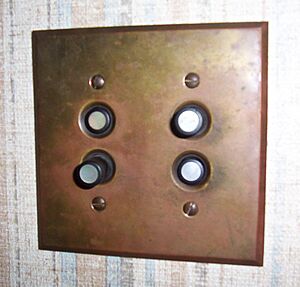Push-button facts for kids
A push-button is a simple switch that you push to make something happen. Think of it like a tiny button or knob. When you press it, it completes an electrical circuit, which is like turning on a path for electricity. This electricity then controls something else. For example, when you push a doorbell button, it makes the bell ring. On a calculator, pushing a button makes numbers appear. Even in arcade games, pushing buttons helps you play!
Contents
What is a Push-Button?
A push-button is a type of switch that works when you press it. It's designed to be pressed and then usually springs back to its original position when you let go. This action either starts or stops an electrical flow. They are very common and you use them every day without even thinking about it!
How Do Push-Buttons Work?
Push-buttons usually have two main parts inside:
- Contacts: These are small pieces of metal that can touch each other.
- Spring: This pushes the button back up after you press it.
When you push the button, the contacts inside touch each other. This closes an electrical circuit, allowing electricity to flow. When you release the button, the spring pushes it back up, and the contacts separate. This opens the circuit, stopping the electricity. Some buttons stay pressed until you push them again, like an on/off switch for a lamp.
Where Do We See Push-Buttons?
Push-buttons are everywhere! They are used in many different devices and machines.
- Home Appliances: You find them on microwave ovens, washing machines, and television remote controls.
- Electronics: Your mobile phone has many buttons, and so do computer keyboards.
- Transportation: Cars have buttons for the radio, windows, and starting the engine. Elevators use buttons to choose floors.
- Games: Video game controllers and arcade machines are full of push-buttons.
- Safety: Emergency stop buttons in factories or on machines are often big, red push-buttons.
Different Kinds of Push-Buttons
Push-buttons come in many shapes, sizes, and colors. Some are small and flat, while others are large and round. They can be made from plastic, metal, or even rubber. Some buttons light up when pressed, and others make a clicking sound. Each type is designed for a specific job.
Images for kids
-
Buttons on a handheld calculator.
See also
 In Spanish: Botón (dispositivo) para niños
In Spanish: Botón (dispositivo) para niños 




